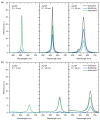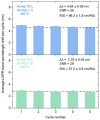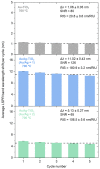Enhancing the Extinction Efficiency and Plasmonic Response of Bimetallic Nanoparticles of Au-Ag in Robust Thin Film Sensing Platforms
- PMID: 38067991
- PMCID: PMC10708804
- DOI: 10.3390/s23239618
Enhancing the Extinction Efficiency and Plasmonic Response of Bimetallic Nanoparticles of Au-Ag in Robust Thin Film Sensing Platforms
Abstract
The extinction efficiency of noble metal nanoparticles (NPs), namely gold (Au) and silver (Ag), are dependent on their size and surrounding dielectric. Exploiting the Localized Surface Plasmon Resonance (LSPR) phenomenon, the composition and structure of the NPs might be tailored to achieve a configuration that optimizes their response (sensitivity) to environmental changes. This can be done by preparing a bimetallic system, benefiting from the chemical stability of Au NPs and the higher scattering efficiency of Ag NPs. To enhance the LSPR sensing robustness, incorporating solid supports in the form of nanocomposite thin films is a suitable alternative. In this context, the NPs composed of gold (Au), silver (Ag), and their mixture in bimetallic Au-Ag NPs, were grown in a titanium dioxide (TiO2) matrix using reactive DC magnetron sputtering. Thermal treatment at different temperatures (up to 700 °C) tuned the LSPR response of the films and, consequently, their sensitivity. Notably, the bimetallic film with Au/Ag atomic ratio 1 exhibited the highest refractive index sensitivity (RIS), with a value of 181 nm/RIU, almost one order of magnitude higher than monometallic Au-TiO2. The nanostructural analysis revealed a wide NP size distribution of bimetallic NPs with an average size of 31 nm, covering about 20% of the overall surface area. These findings underscore the significant potential of bimetallic film systems, namely AuAg-TiO2, in LSPR sensing enhancement.
Keywords: Au-Ag nanoparticle; AuAg-TiO2 thin film; Localized Surface Plasmon Resonance (LSPR); plasmonics; refractive index sensitivity (RIS).
Conflict of interest statement
The authors declare no conflict of interest.
Figures







Similar articles
-
Tuning the Refractive Index Sensitivity of LSPR Transducers Based on Nanocomposite Thin Films Composed of Noble Metal Nanoparticles Dispersed in TiO2.Materials (Basel). 2023 Nov 26;16(23):7355. doi: 10.3390/ma16237355. Materials (Basel). 2023. PMID: 38068099 Free PMC article.
-
Critical Issues on the Surface Functionalization of Plasmonic Au-Ag/TiO2 Thin Films with Thiolated Oligonucleotide-Based Biorecognition Elements.Biosensors (Basel). 2024 Mar 27;14(4):159. doi: 10.3390/bios14040159. Biosensors (Basel). 2024. PMID: 38667152 Free PMC article.
-
Low-density Ag-Au nanoparticle photodeposition on TiO2 thin film photocatalysts grown by atomic layer deposition.Phys Chem Chem Phys. 2025 Aug 13;27(32):16865-16874. doi: 10.1039/d5cp00834d. Phys Chem Chem Phys. 2025. PMID: 40718995
-
Recent Advances in Silver and Gold Nanoparticles-Based Colorimetric Sensors for Heavy Metal Ions Detection: A Review.Crit Rev Anal Chem. 2023;53(3):718-750. doi: 10.1080/10408347.2021.1973886. Epub 2021 Sep 12. Crit Rev Anal Chem. 2023. PMID: 34510976 Review.
-
Plasmonic nanoparticle sensors: current progress, challenges, and future prospects.Nanoscale Horiz. 2024 Nov 19;9(12):2085-2166. doi: 10.1039/d4nh00226a. Nanoscale Horiz. 2024. PMID: 39240539 Free PMC article. Review.
References
-
- Stockman M.I. Nanoplasmonics: The physics behind the applications. Phys. Today. 2011;64:39–44. doi: 10.1063/1.3554315. - DOI
-
- Divya J., Selvendran S., Raja A.S., Sivasubramanian A. Surface plasmon based plasmonic sensors: A review on their past, present and future. Biosens. Bioelectron. X. 2022;11:100175. doi: 10.1016/j.biosx.2022.100175. - DOI
-
- Stockman M.I., Kneipp K., Bozhevolnyi S.I., Saha S., Dutta A., Ndukaife J., Kinsey N., Reddy H., Guler U., Shalaev V.M., et al. Roadmap on plasmonics. J. Opt. 2018;20:043001. doi: 10.1088/2040-8986/aaa114. - DOI
Grants and funding
LinkOut - more resources
Full Text Sources
Miscellaneous

